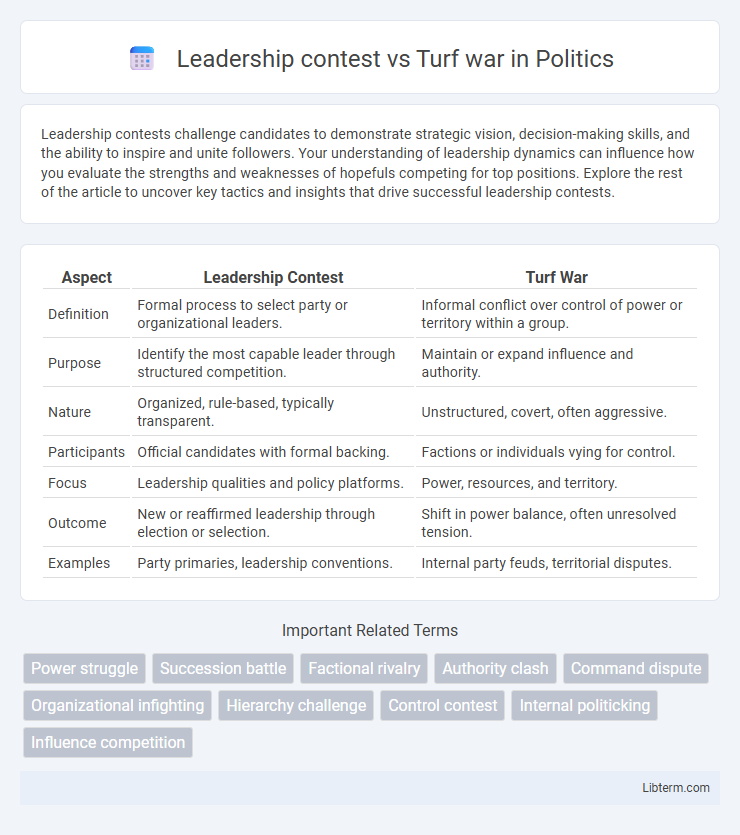Leadership contests challenge candidates to demonstrate strategic vision, decision-making skills, and the ability to inspire and unite followers. Your understanding of leadership dynamics can influence how you evaluate the strengths and weaknesses of hopefuls competing for top positions. Explore the rest of the article to uncover key tactics and insights that drive successful leadership contests.
Table of Comparison
| Aspect | Leadership Contest | Turf War |
|---|---|---|
| Definition | Formal process to select party or organizational leaders. | Informal conflict over control of power or territory within a group. |
| Purpose | Identify the most capable leader through structured competition. | Maintain or expand influence and authority. |
| Nature | Organized, rule-based, typically transparent. | Unstructured, covert, often aggressive. |
| Participants | Official candidates with formal backing. | Factions or individuals vying for control. |
| Focus | Leadership qualities and policy platforms. | Power, resources, and territory. |
| Outcome | New or reaffirmed leadership through election or selection. | Shift in power balance, often unresolved tension. |
| Examples | Party primaries, leadership conventions. | Internal party feuds, territorial disputes. |
Defining Leadership Contests and Turf Wars
Leadership contests involve structured competitions where individuals or groups vie for formal authority or positions within organizations, often guided by established rules and procedures. Turf wars refer to conflicts arising from overlapping interests or control over resources, territories, or responsibilities without formal mechanisms for resolution. Defining leadership contests emphasizes organized power transitions, whereas turf wars highlight informal struggles for dominance or influence.
Key Differences Between Leadership Contests and Turf Wars
Leadership contests center on selecting the best candidate through formal processes like elections or votes, emphasizing merit and vision for organizational direction. Turf wars involve informal power struggles where individuals or groups compete to control resources or influence, often creating internal conflict and reducing collaboration. The key difference lies in leadership contests aiming for constructive decision-making, while turf wars breed rivalry and hinder organizational efficiency.
Motivations: Ambition vs. Territoriality
Leadership contests are driven primarily by ambition, with individuals seeking to assert influence and gain recognition for their strategic vision and decision-making capabilities. Turf wars stem from territoriality, where the motivation centers on protecting and maintaining control over established domains, resources, or power bases within an organization. While ambition fuels the pursuit of higher leadership roles and broader impact, territoriality emphasizes defense and preservation of existing authority and assets.
Impact on Organizational Culture
Leadership contests often inspire innovation and constructive competition, boosting organizational culture by fostering transparency and meritocracy. In contrast, turf wars create silos and distrust, undermining collaboration and leading to a culture of fear and internal conflict. The resulting impact heavily influences employee morale, productivity, and long-term organizational cohesion.
Signs You’re Facing a Leadership Contest
Frequent challenges to your decisions, sudden shifts in team loyalty, and increased questioning of your authority are clear signs you're facing a leadership contest. Pay attention to behind-the-scenes maneuvering, such as covert alliances or personnel changes aimed at undermining your position. These behaviors often indicate a strategic effort to replace or discredit you in the leadership hierarchy.
Recognizing a Turf War in the Workplace
A turf war in the workplace is identified by persistent conflicts over control, resources, or authority between individuals or departments, often causing reduced collaboration and productivity. Signs include repeated confrontations, territorial behavior, and communication breakdowns that hinder goal alignment. Early recognition of these conflicts allows leaders to implement conflict resolution strategies and promote a culture of cooperation.
Outcomes: Growth or Gridlock?
Leadership contests often drive organizational growth by fostering innovation, strategic alignment, and motivated teams focused on clear goals. Turf wars typically result in gridlock, characterized by internal conflicts, reduced collaboration, and slowed decision-making processes that hinder progress. Companies experiencing leadership contests report higher performance metrics, while those mired in turf wars face decreased productivity and employee morale.
Strategies for Navigating Leadership Contests
In navigating leadership contests, candidates should prioritize building broad coalitions by engaging diverse stakeholder groups to secure widespread support. Effective communication of a clear vision and demonstrating proven leadership capabilities enhance credibility and influence during competition. Strategic alliance formation and continuous engagement with key influencers increase the likelihood of success while minimizing internal conflict akin to turf wars.
Managing and Resolving Turf Wars
Managing and resolving turf wars in leadership contests involves clear communication of roles, promoting collaboration, and establishing shared goals to minimize conflicts. Implementing structured conflict resolution strategies such as mediation and transparent decision-making processes helps prevent power struggles. Encouraging a culture of mutual respect and recognizing individual contributions fosters unity and effective team performance.
Building Healthy Competition Over Destructive Rivalries
Building healthy competition in leadership contests fosters innovation, collaboration, and organizational growth by encouraging diverse ideas and mutual respect among team members. Turf wars, characterized by destructive rivalries, often result in decreased productivity, fragmented teams, and stagnation due to power struggles and lack of shared vision. Prioritizing transparent communication and common goals helps transform competitive dynamics into constructive leadership development and sustainable success.
Leadership contest Infographic

 libterm.com
libterm.com